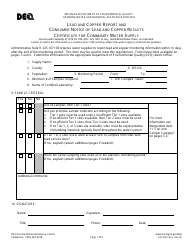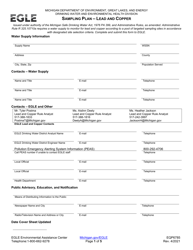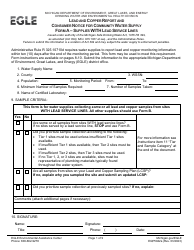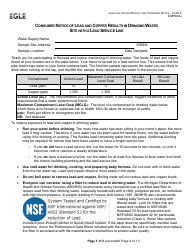Form EQP5844 Lead and Copper Sampling Plan - Michigan
What Is Form EQP5844?
This is a legal form that was released by the Michigan Department of Environment, Great Lakes, and Energy - a government authority operating within Michigan. As of today, no separate filing guidelines for the form are provided by the issuing department.
FAQ
Q: What is the EQP5844 Lead and Copper Sampling Plan?
A: The EQP5844 Lead and Copper Sampling Plan is a document that provides guidelines and procedures for sampling and testing lead and copper levels in drinking water in Michigan.
Q: Why is lead and copper sampling important?
A: Lead and copper can leach into drinking water from pipes and plumbing fixtures, posing health risks. Regular sampling helps monitor and ensure safe drinking water.
Q: Who is responsible for implementing the EQP5844 Lead and Copper Sampling Plan?
A: The EQP5844 Lead and Copper Sampling Plan is implemented by water utilities and agencies responsible for regulating drinking water quality in Michigan.
Q: How often should lead and copper sampling be conducted?
A: Lead and copper sampling should be conducted every three years for water systems serving more than 50,000 people, and every six years for smaller systems.
Q: What are the sampling procedures outlined in the EQP5844 Lead and Copper Sampling Plan?
A: The EQP5844 Lead and Copper Sampling Plan outlines procedures for selecting sampling sites, collecting water samples, and analyzing them for lead and copper concentrations.
Q: What are the acceptable lead and copper levels in drinking water?
A: The acceptable lead level in drinking water is 15 parts per billion (ppb), and the acceptable copper level is 1.3 milligrams per liter (mg/L).
Q: What happens if lead or copper levels exceed the acceptable limits?
A: If lead or copper levels exceed the acceptable limits, water utilities and regulatory agencies are required to take corrective actions, such as implementing corrosion control measures or replacing lead service lines.
Q: How can residents ensure the safety of their drinking water?
A: Residents can ensure the safety of their drinking water by following any advisories or guidelines provided by their water utility, and by using certified lead filters if necessary.
Form Details:
- Released on November 1, 2021;
- The latest edition provided by the Michigan Department of Environment, Great Lakes, and Energy;
- Easy to use and ready to print;
- Quick to customize;
- Compatible with most PDF-viewing applications;
- Fill out the form in our online filing application.
Download a fillable version of Form EQP5844 by clicking the link below or browse more documents and templates provided by the Michigan Department of Environment, Great Lakes, and Energy.















